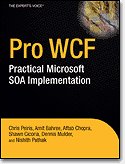In respect to lot of mails that i received about Table Of Contents(TOC) of our book , so here is the attached TOC for my book, Pro WCF: Practical Microsoft SOA Implementation for APress Publication. The book is divided into three parts, with first being the introduction to WCF , second about programming and third on Advanced topics of WCF.
PART 1 Introducing Windows
Communication Foundation
nCHAPTER 1 Introducing Service-Oriented Architecture . . . . . . 3
nCHAPTER 2 Introducing WCF Basics . . . . . . 25
nCHAPTER 3 Exploring the WCF Programming Model . . . . . . . 51
PART 2 Programming with WCF
nCHAPTER 4 Installing and Creating WCF Services . . . . . . . . . . . . . 99
nCHAPTER 5 Hosting and Consuming WCF Services . . . . . . . . .145
nCHAPTER 6 Managing WCF Services . . . . . . . . . . . . . . . . . . 179
PART 3 Advanced Topics in WCF
nCHAPTER 7 Implementing WCF Security . . . . . . . . . . . . . . . .. . . . .213
nCHAPTER 8 Implementing Reliable Messaging and Queue-Based
Communications . . . . . . . . . . . . . . . . . . . . . . . . . 249
nCHAPTER 9 Using Transactions in WCF . . . . . . . . . . . . . . 277
nCHAPTER 10 Integrating with COM+ . . . . . . . . . . . . . . . . . . .301
nCHAPTER 11 Working with Data . . . . . . . . . . . . . . . . . . . . . . . .335
nCHAPTER 12 Developing Peer-to-Peer Applications with WCF . . . . . . . . . . 371
nCHAPTER 13 Implementing SOA Interoperability . . . . . . . . . . . . . . . . . . . . 401
PART 4 Appendixes
nAPPENDIX A QuickReturns Ltd. . . . . . . . . . . . . . . . . . . . . . . . . . . 425
nAPPENDIX B History of Microsoft Web Service Implementations . . . . . . . . .431
nAPPENDIX C WCF and .NET Framework Installation Steps . . . . . . . . . . . . . 441
